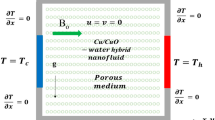Abstract.
This paper analyzes the convective heat transfer enhancement mechanism of microencapsulated phase change material slurries based on the analogy between convective heat transfer and thermal conduction with thermal sources. The influence of each factor affecting the heat transfer enhancement for laminar flow in a circular tube with constant wall temperature is analyzed using an effective specific heat capacity model. The model is validated with results available in the literature. The analysis and the results clarify the heat transfer enhancement mechanism and the main factors influencing the heat transfer. In addition, the conventional Nusselt number definition of phase change slurries for internal flow is modified to describe the degree of heat transfer enhancement of microencapsulated phase change material slurries. The modification is also consistent evaluation of the convective heat transfer of internal and external flows.














Similar content being viewed by others
Abbreviations
- c:
-
volumetric concentration of microcapsules
- cm :
-
mass concentration of microcapsules
- cp :
-
specific heat, kJ kg–1 K–1
- hfs :
-
phase change material heat of fusion, kJ kg–1
- hm*:
-
modified convective heat transfer coefficient, W m–2 K–1
- k:
-
thermal conductivity, W m–1 K–1
- ke :
-
effective thermal conductivity of slurry, W m–1 K–1
- kb :
-
slurry bulk thermal conductivity, W m–1 K–1
- ML:
-
dimensionless initial subcooling
- Mr:
-
dimensionless phase change temperature range
- Nu:
-
conventional Nusselt number
- Nu*:
-
improved Nusselt number
- qw n :
-
wall heat flux, Wm–2
- Pe:
-
Peclet number
- Pr:
-
Prandtl number
- Re:
-
Reynolds number
- r:
-
radial coordinate, m
- r0 :
-
duct radius, m
- r1 :
-
dimensionless radial coordinate
- Ste:
-
Stefan number
- T:
-
temperature, K
- T1 :
-
lower phase change temperature limit, K
- T2 :
-
upper phase change temperature limit, K
- Ti :
-
slurry inlet temperature, K
- u:
-
axial velocity, m/s
- v:
-
radial velocity, m/s
- x:
-
axial coordinate, m
- x1 :
-
dimensionless axial coordinate
- α:
-
thermal diffusivity, m2/s
- θ:
-
dimensionless temperature
- μ:
-
dynamic viscosity, N·s/m2
- ν:
-
kinematic viscosity, m2/s
- δt :
-
width of thermal boundary, m
- η:
-
degree of heat transfer enhancement, η = hm*/(hm*)single
- b:
-
bulk fluid (slurry)
- b0:
-
slurry without phase change
- l:
-
liquid
- m:
-
mean
- s:
-
solid
- f:
-
suspending fluid
- p:
-
microcapsule particles
- w:
-
wall
- single:
-
single-phase fluid
References
Charunyakorn P; Sengupta S; Roy SK (1991) Forced convection heat transfer in microencapsulated phase change material slurries: flow in circular ducts. Int J Heat Mass Transfer 34(3): 819–833
Colvin DP; Mulligan JC; Bryant YG (1992) Enhanced heat transport in environmental systems using microencapsulated phase change materials. SAE Trans 101: 717–725
Choi E; Cho YI; Lorsch HG (1992) A Study of convective heat transfer with phase change particles. ASME HTD 220: 45–49
Goel M; Roy SK; Sengupta S (1994) Laminar forced convection heat transfer in microencapsulated phase change material suspensions. Int J Heat Mass Transfer 37(4): 593–604
Choi E; Cho YI; Lorsch HG (1994) Forced convection heat transfer with phase change material slurries: turbulent flow in a circular tube. Int J Heat Mass Transfer 37(2): 207–215
Zhang YW, Faghri A (1995) Analysis of forced convection heat transfer in microcapsulated phase change material suspensions. J Thermophys Heat Transfer 9(4): 727–732
Mulligan JC; Colvin DP; Bryant YG (1996) Microencapsulated phase-change material suspensions for heat transfer in spacecraft thermal systems. J Spacecraft Rockets 33(2) March–April: 278–284
Yamagishi Y; Takeuchi H; Pyatenko AT; Kayukawa N (1999) Characteristics of microencapsulated pcm slurry as a heat-transfer fluid. AICHE J 45(4): 696–707
Alisetti EL; Roy SK (2000) Forced convection heat transfer to phase change material slurries in circular ducts. J Thermophys Heat Transfer 14(1): 115–1180
Guo ZY; Li DY; Wang BX (1998) A novel concept for convective heat transfer enhancement. Int J Heat Mass Transfer 41(14): 2221–2225
Guo ZY; Wang S (2000) Novel concept and approaches of heat transfer enhancement. In: Proceedings of Symposium on Energy Engineering in the 21st Century (SEE 2000) 1: 118–126
Acknowledgements.
This work was supported by the National Natural Science Foundation of China (Grant No. 50076020), the Department of Science and Technology of China (Grant no. G2000026309), and the Excellent Young Faculty Foundation of the Ministry of Education of China. The authors thank Prof. Z.Y. Guo of the Deptartment of Engineering Mechanics, Tsinghua University, Beijing, for his suggestions concerning the present paper.
Author information
Authors and Affiliations
Corresponding author
Rights and permissions
About this article
Cite this article
Zhang, Y., Hu, X. & Wang, X. Theoretical analysis of convective heat transfer enhancement of microencapsulated phase change material slurries. Heat and Mass Transfer 40, 59–66 (2003). https://doi.org/10.1007/s00231-003-0410-7
Received:
Published:
Issue Date:
DOI: https://doi.org/10.1007/s00231-003-0410-7




